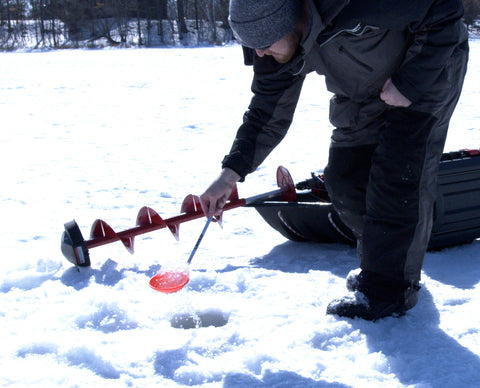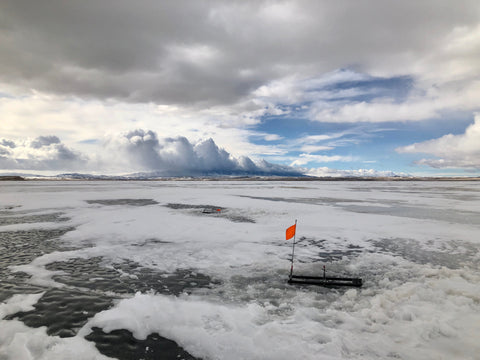Whether you’re new to hard water fishing or an old ice salt, there’s a list of obvious essentials you will need in all cases, and another more expansive list of nice-to-haves that will help make your time on the ice much more productive and enjoyable.
Ice fishing is really a bit of an extreme sport if you think about it. Many people in the warmer climes scarcely believe it is done in such conditions, or that we drive ATVs, trucks and massive heated campers onto the frozen lakes of the north. To them, we are probably seen as a hearty, often fearless people.
I was covering a stock car race in New Richmond, Wisconsin a few years back, and we toured the camping section of the grounds. The show host asked me about the rows and rows of ice shack campers that filled the space. He had never heard of such a thing, even though in our northern culture they literally are THE new camper for outdoor enthusiasts.

Many are toy haulers, which means the ATVs or snowmobiles tuck right into the back of the camper and away you go. Genius really.

The creature comforts of these ice shacks have made a trip out onto the windswept, godforsaken landscape of a frozen lake like a trip to Disneyworld for families, as this particular outing demonstrates - The Ice People profiles one such adventure.
But regardless of the level you intend to embark upon, from an auger and a bucket up to an Ice Palace, (yes that’s a brand), you will find the same jolt of adrenaline when the tip-up, rattle reel or ice rod gets bent. It’s all still fishing at the end of the day.
Just don’t expect it to be just like summer fishing. It’s usually a tougher room than that. I know - oof. This is why it’s so rewarding to watch a fish come up through the ice...

THE ESSENTIALS
It all begins with drilling holes. But first, let’s back up to before we even hit the ice. You need to consider a few things when it comes to outerwear. There’s a few functions it needs to serve in order for you to be safe and comfortable.

OUTERWEAR
Floatation - probably not top of mind for most, but it is the most important factor for you and your loved ones to have peace of mind. Your life is not worth risking a few panfish over, and your list should begin with a Floating Ice Suit like this Boreas Suit from WindRider.
Bibs - no ice suit is complete without a good pair of bibs as a base layer, and they too should float, The WindRider Boreas Bibs also offer hand warming pockets and double zippers (for EASY bathroom breaks). You hadn’t thought of that I bet.
Pockets - you should have them for bait, your phone, gloves, snacks - you get the idea. Zippers and storm flaps are the perfect gate keepers to prevent losing critical items.
Waterproof yet Breathable - this is one of the main functions of good outerwear. You should look for clothing that sheds water outside, and wicks perspiration inside. Total comfort.
Reinforcements - look for them on the knees and butt in particular. Ruggedness is key, plus you will be kneeling and possibly sitting in water, and that seeping through is no fun. No fun.
So once you have added the proper accessories such as Floating Gloves, Floating Sunglasses, a good thermal hat, suitable winter boots and heavy socks and you’re off to the lake. Now let’s address the essential fishing gear you should be bringing along.

Ice Auger - you can’t ice fish without holes, so this one is a given, unless you’re fishing with someone who has one. They have become increasingly cordless electric, though there are gas and propane powered ones out there. Also don’t overlook hand augers, which are affordable and help buff up those arms. They come in well under $100, while the others will run you between $300 and $600. Think portability when choosing one, considering how many times you’ll be using and transporting it.

Fishing Rods - ice rods are obviously much shorter and thus resemble miniature fishing rods. Years back they were made with points to stab into the snow, but now rod holders are pretty standard equipment. Most feature extremely sensitive spring tips to detect light bites. It’s best to simply browse and try to find rods that work for you. You can get started with rod/reel combos from about $20 on up, with best sellers like this Ugly Stik GX2 Ice Combo coming in at a bit more but well worth it. Oh, and get a few if possible.

Ice skimmer - these handy tools are inexpensive and invaluable to keeping your ice holes free of gathering crystals and slush.
Tackle - ice tackle is typically downsized as well, with small wax worms, tiny scented fry baits on jigheads that go down to 1/72 ounce. Detecting the light bites of wary winter panfish requires an entirely different set of line, lures and rod tips. There are a myriad of small spoons available, and iconic hard water baits like the Rapala Jigging Rap and the Salmo Chubby Darter are great places to start.

Buckets - these no doubt started as 5 gallon pails that proved to be the right size for carrying accessories and bait, and have now become multi-use utility standards that include swivel seats, insulated bait wells and organizers that keep all your gear essentials together.
Sled - as you may have guessed, all this gear is starting to add up, and you’ll need efficient transportation. Even if you’re using an ATV or UTV, having a good sturdy sled is essential to moving gear around on hard water. These heavy duty sleds have sides up to 12” high with sturdy construction and nylon tow ropes.

NICE-TO-HAVES
Now that we’ve covered the essentials, let's move onto some of the gear that will make ice fishing easier and more productive. We’ll start with one of the most obvious - transportation to and from your spots.
Snowmobiles offer a great option, though they may be more limited in passenger and cargo options. They tend to be faster if you’ve got long runs, or just like the charge that a good blast across open ice offers.

ATVs and UTVs have become the workhorses of outdoor recreation, and ice fishing is no exception. They offer stability, cargo space and creature comforts like cabs and multiple passenger options that enable those who might not otherwise be able to participate.

Vehicles - of course, full-sized vehicles become options once you have at least 8” to 12” of solid ice at your disposal. Ice roads are common on popular lakes, but use caution early and late in the season when getting on and off the lakes becomes a messy proposition. There may be stable ice, but getting to it is now the problem. So is the guy you pissed off by blocking the lake access. It happens.

Shelter - so these will run from portable pop-ups to full-blown campers with holes in the floor. Ice shacks have dotted the frozen lakes as long as anglers have been stubborn enough to insist upon minimal comforts while pursuing elusive winter fish.

Tip Ups - these ubiquitous contraptions are a mainstay for hard water anglers that like to hole hop. A raised flag means the line has been set off, and the fun begins. Tip ups are a great way to cover a large area and monitor your results on the fly.
Rod Case - depending on how many sticks you usually keep in tow, this is a great way to keep it all protected and avoid tangling the rods together. They are generally hard-sided and will hold 6 to 12 rods.

Rattle Reels - A rattle reel is a specially designed reel that attaches to the side of a wheelhouse, ice shanty, or even a bucket and is meant for ice fishing a suspended bait and it can be very good for catching fish. They let you attend to other things, and alert you to a bite with their telltale rattle.

Ice Picks - these will become good utility items for early and late ice once you grow more adventurous and find yourself yearning to get out there even though vehicles are inadvisable. These picks generally come with a tether to go around your neck that makes them accessible in an emergency. They will offer you the leverage to pull yourself to safety should you wind up in the water. They work well in conjunction with a floating ice suit to ensure peace of mind for you and your loved ones.

Electronics - ok so not everyone will tell you this, but ice fishing can be very boring at times, (no, really), and without electronics you’re generally punching holes with the best hopes for finding fish, versus punching holes and having a fish finder like our favorite, the Garmin LiveScope actually point you toward the fish should they not be near you. It enables you to scan 360 degrees around your spot at all water column levels.
It simply takes the guesswork out of finding fish, and then makes catching them more like a video game as you watch your bait and anything that approaches it. It is a tool that is almost guaranteed to entice kids to ice fish. Plus, of course those same electronics will serve you well in your boat, so, two birds...

Spear - spearing fish through the ice is one of the more exhilarating ways you can fish on hard water. It is typically done in a darkhouse that has a hole that is roughly 2’ by 4’ to launch the spear at the fish. A small decoy draws the fish right beneath your waiting spear. The rest is up to you.
The spears are all metal with 5 to 7 tines usually, and launching them will take a bit of practice. Bear in mind that every time you stir up that bottom it will take awhile settle down again. Oh, and by all means check local regulations before using them.

Once you have assembled all the necessary gear, (and any nice-to-haves), ice fishing will offer you a lifetime of winter recreation, a great source of fresh fish, and the opportunity to make memories out on the ice. Fish on! -WR

